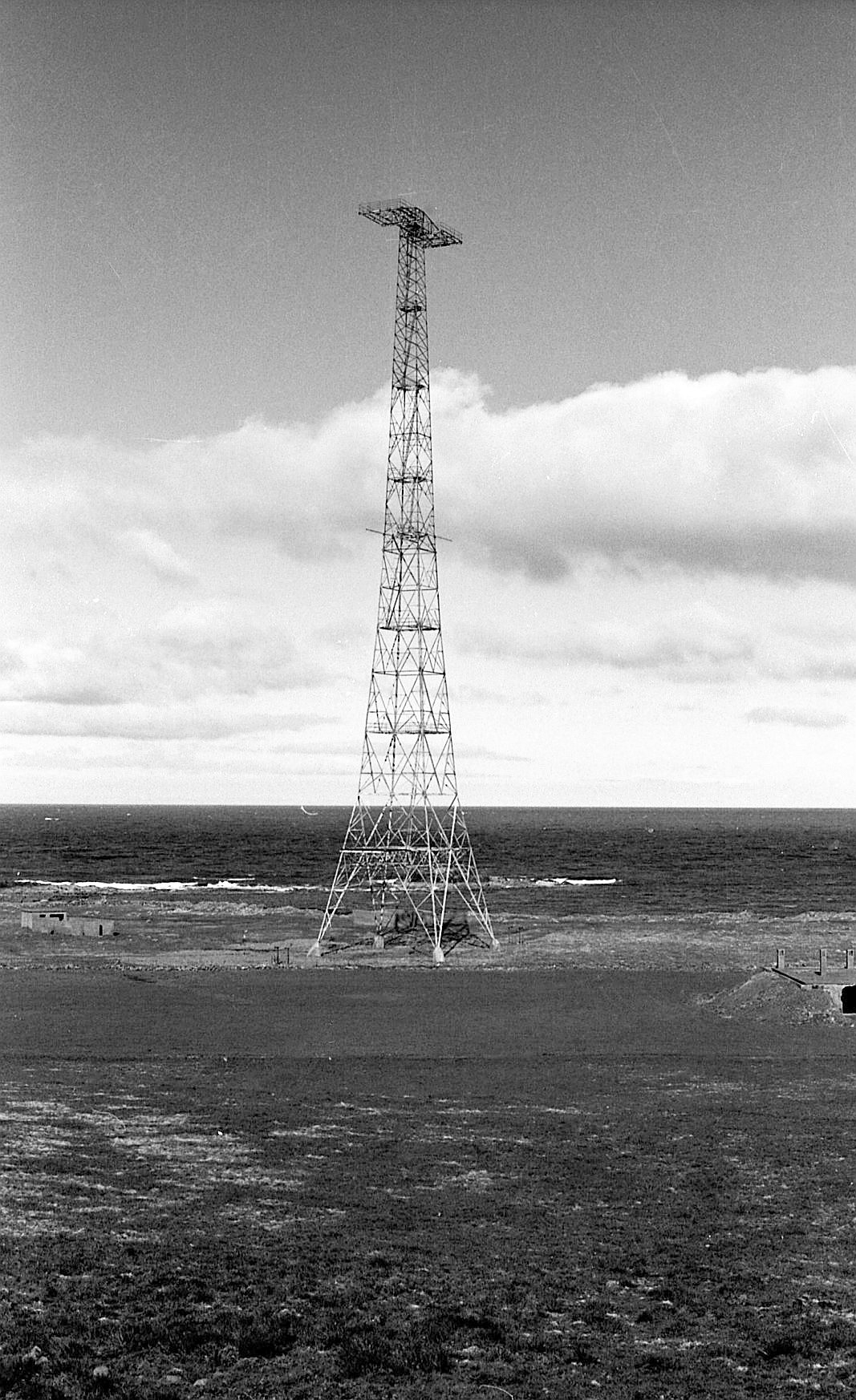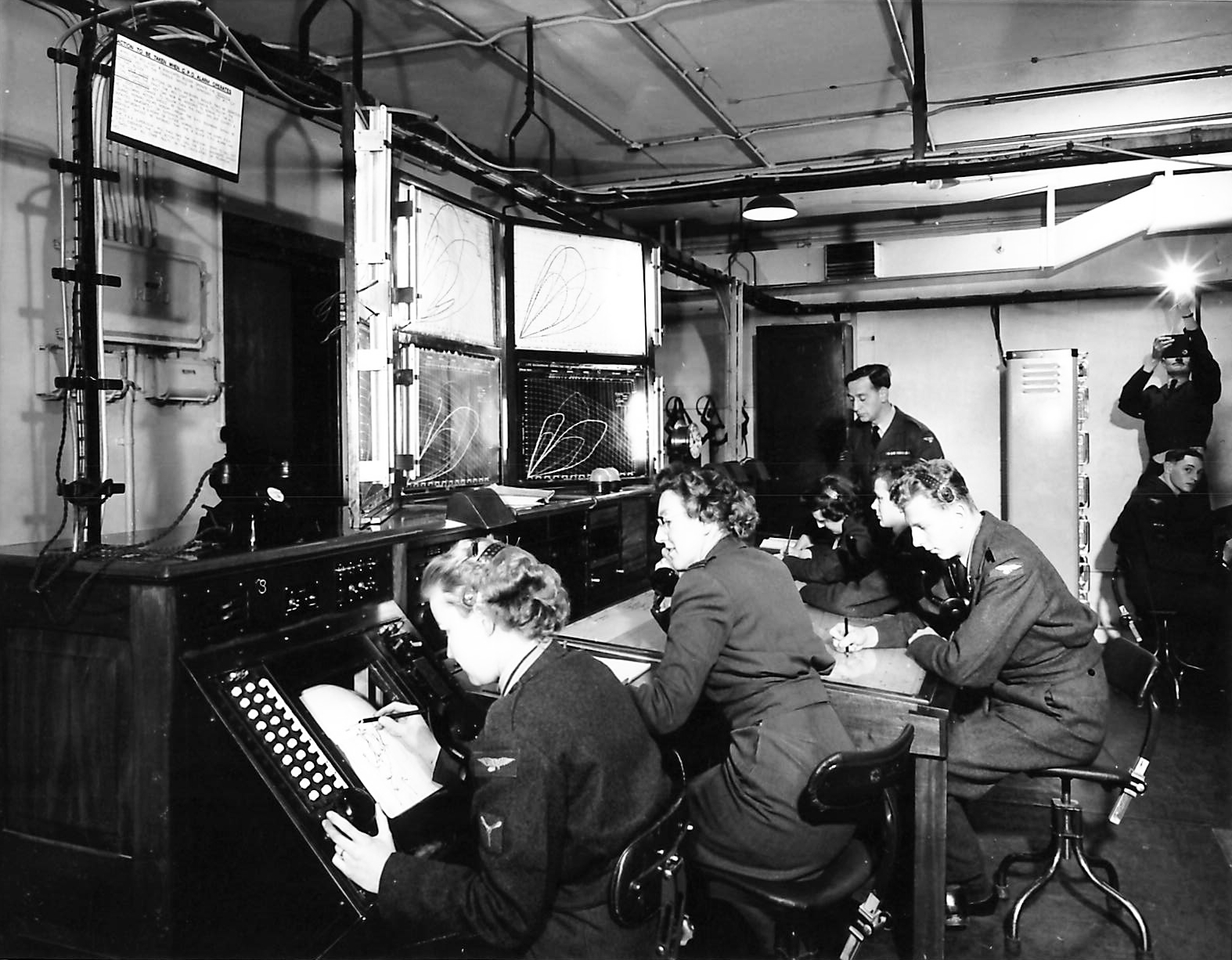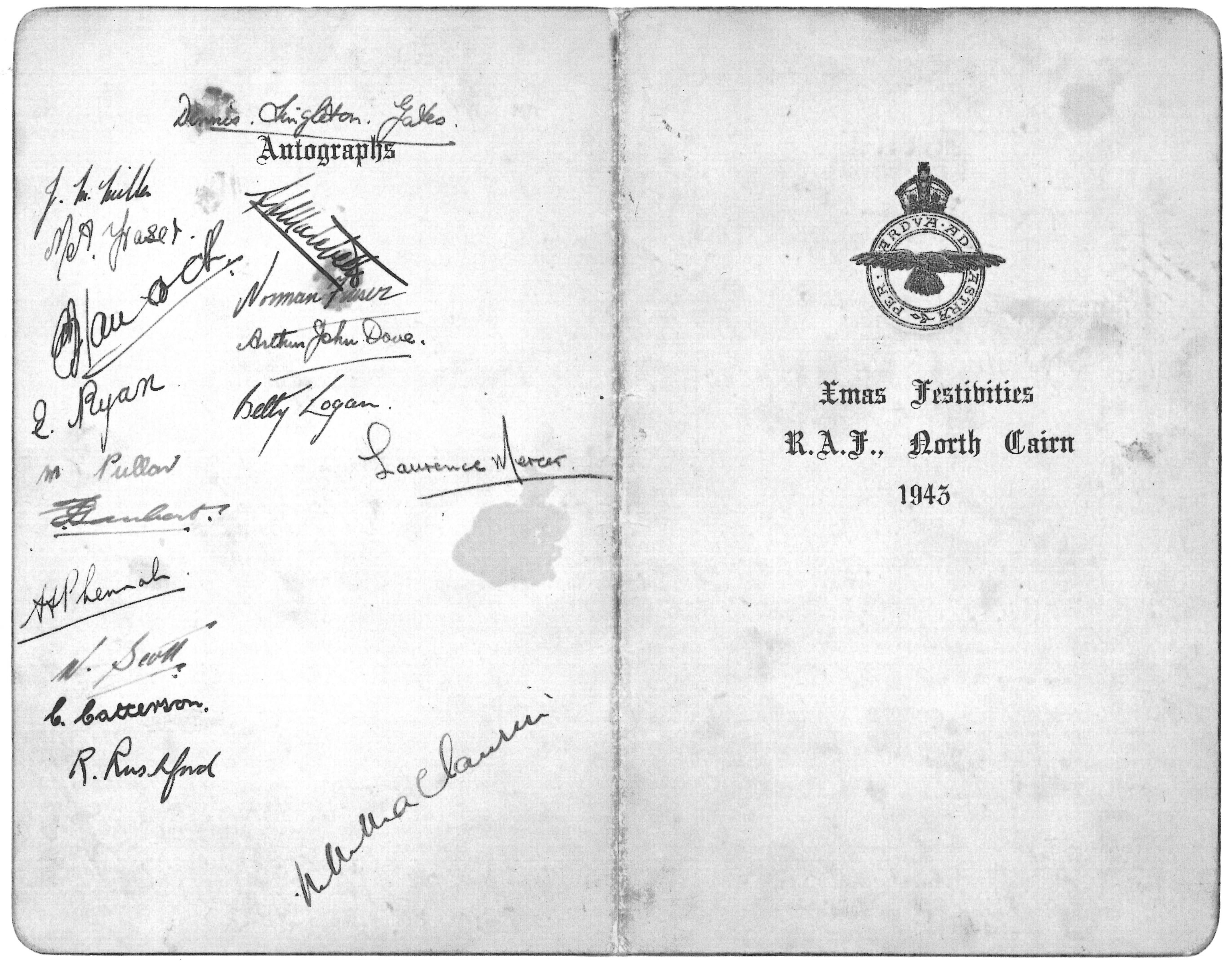Having retired from full time employment in 2018 I moved to a part of the world I had known as a lad. This brought me to the parish of Kirkcolm at the top of the Rhins of Galloway in the bottom left hand corner of Scotland. My parents lived locally and I knew the area and had walked the coastal path a number of times in the past. These occasional walks took me past a large tower in a field by the sea. Scattered across the fields by the tower were three heavily revetted buildings. The attached photograph is the last surviving tower I am referring to and one of the buildings in a field, which I took in 1981.
When I first saw the mast I assumed it was for radio transmission and receiving and was probably of World War 2 vintage but gave it little thought at the time. A few years later I picked up a book called “The RAF in Galloway 1910 – 2000” by A. T. Murchie, an ex RAF serviceman. From this I learned that the tower and the buildings were part of RAF North Cairn. The book didn’t contain a great deal of detail other than to say it was a Chain Home radar station which was operational from 1940 to 1945.
I left it there until the recent Chinese Flu epidemic which constrained our movements. I decided to learn more about RAF North Cairn and pull what I could together into one document. I had no initial plan to do anything more than get a report together which I could share with those who were interested such as neighbours and anyone who contributed to my researches.
With this in mind I did a search on the internet and purchased a book about the Second World War radar in the UK. RAF North Cairn was mentioned a few times and I paraphrased these references into my document. My researches were driven by a desire to as know as much as I could about RAF North Cairn and to ask the question “so what?”. When I learned something new I asked “so what”. I spoke to my neighbour who had been a child in the farm next door to North Cairn and he gave me anecdotes about the station as well as valuable information about the accommodation buildings a mile away from the operational site by the sea, and also the NAAFI buildings and nearby Army barracks. The Army provided security on the operational site for the first few years of it’s existence. The retired farmer who used to own North Cairn farm told me about the buildings by the sea, the camps water supply, electricity and telephone service and even the sewage system. Yes, I wanted to know it all.
At the same time I did searches on-line at The National Archive, got more books about Second World War radar and approached my local Historical Society. During periods when the Wuhan Flu restrictions were eased I went to the National Archive twice to scan with my mobile phone the Operations Record Book of 72 Wing as there were none surviving for RAF North Cairn itself. I also scanned and then studied correspondence within 60 Signals Group about the base and it’s development, particularly why and how it was chosen and the alternative sites that were considered. Two visits to the National Archive were necessary as I learned more about the station and it’s reporting of radar plots to No.9 Group and then to RAF Northern Ireland.
My approach to the local Historical Society drew a blank which is not surprising as the base was secret during the war and at an out of the way place for casual visitors. They did however refer me to a person who’s mother had been posted to RAF North Cairn for a few weeks prior to being posted to RAF Yatesbury for radar operator training. She kept a diary and I was able to see a few pages of it that related to her stay there and from these pages I learned about small details such as the watch system in operation, leisure activities, the bus service to town and the local phone box which she used to call home. The last two points striking a cord with locals who recalled these services as well. The son of the WAAF radar operator toured the country to the various places his mother served and I was able to show him around the site where his mother worked and where she was accommodated.
The document needed some human interest as the information I gathered from official documents tended to be technical and hence dry in nature. The books I read about radar in the Second World War had service peoples experiences which helped here as did the diary referred to above. In addition, an oral history project had interviewed a chap who was an apprentice builder in the district and had actually worked on the site. His experiences were really important, such as the need to make room for additional equipment in the receiver buildings and to do this they had to use a hammer and chisel to expand the entrances they had originally built for this purpose and the tight security they operated under whilst doing this.
In the same way that there was no record of the station ORBs (Form 540) for RAF North Cairn there were also no diagrams of the buildings or station layout. These would have been drawn up by the Air Ministry Works Department with input from 60 Signals Group and Air Ministry Research Establishment scientists. To overcome this I went to the National Collection of Aerial Photographs which had an aerial photograph of the station taken in 1946, a year after the station was closed down. All the buildings were still there to be seen, nearly all of which had been knocked down over the years by the incumbent farmer. Though I couldn’t identify all the buildings and their purpose I was able to do this for most of them. These went into the report along with colour photos I had taken over the years showing the derelict buildings or just the concrete bases left after their destruction.
Every radar site kept a record of the radar plots they made as well as passing them onto a Group plotting room. Again, these weren’t kept so I had to rely upon local anecdotes and books for assistance. There was anecdotal mention of German weather aircraft plotted beyond the North Channel and reference to much friendly aircraft activity in the area as there was a great number of training flights from nearby RAF stations. The books told me that the raids on Belfast in April and May 1941 would almost certainly have been plotted as they approached from the south over County Down as RAF North Cairn covered this area. A Royal Observer Corps member spotted German bombers passing up the Irish Sea and onto the Clyde for raids in that area which would almost certainly have been plotted by RAF North Cairn radar operators.
Whilst pulling all this information together into a document it started to grow in size. The photographs l had were better than nothing so they went into the document. I contacted The RAF Air Defence Radar Museum and the archivist there was very helpful. He provided a list of their digitally scanned photographs and I was able to get images of the standby generator, the transmitter and receiver equipment and staff using the equipment for the operational site. They even provided an Air Ministry publication with the recommended establishment of staff at a Chain Home radar station. It was all coming together.
More research indicated that the electric substation which was partly buried into the side of a hill is the only surviving one in Scotland if not the UK. Another conversation with the farmer of North Cairn lead to the recollection that it was in the Summer of 1940 that the fields by the sea were almost ready for harvest when they were requisitioned and out of bounds to all. The farmer mentioned a rumour that Tony Hancock had been posted to RAF North Cairn. Two biographies of his both confirmed that he had worked there but that he had been posted to RAF Wig Bay a few miles away. Whilst cleaning the RAF ablutions he got chatting to a radar technician and found they both had a shared interest in shows and entertainment and they both partook in a Christmas show on the base. The photograph of the 1943 Christmas show menu includes his autograph near the top left hand corner. Other entertainment at the station included a show by Sir Harry Lauder which local farmers could attend as well.
Throughout all this I maintained a bibliography of all the factual information I had used in the document. I wanted the report to be as detailed a record as possible of what took place at RAF North Cairn. All I needed to do was the Acknowledgements and an Introductory section giving an overview of aircraft early warning prior to radar and the early days of it’s development to place it in context.
I read and reviewed the document three or four times replacing the clunky sentences with grammatically easier to read sections of text. I then had some prints made by a local printer. I shared these with those who had contributed to the document including the RAF Museum, some of my neighbours and my local Historical Society. In so doing I was asked by the village Community Trust to do a presentation one evening which I did. About 20 people turned up for this. I was then invited to give a presentation to the local PROBUS group and then the local Antiquarians followed by the Galloway Association of Glasgow.
A long distance path is being developed around the coast of Galloway and I was asked to provide photos and information about RAF North Cairn for an information board which will be erected by the path next to the operational site by the sea. The developers of the path have had archaeological digs carried out and they decided to carry out a survey of the site as a matter of record which I was able to help with. See the link below for an interactive video of an aerial view they took after a light scattering of snow in 2022.
In promoting the path they got the local ITV evening magazine programme to include sections of the path and I even found myself in front of a camera for a few minutes.
Lastly, my local history society which is a registered charity are going to publish my book which should be available by the time this article appears.
It’s been a fascinating journey learning about early radar in the RAF and meeting a lot of good and generous people along the way. It has brought me into contact with many neighbours I wouldn’t have otherwise met. Ironically, my first posting after completing the Supplier General apprenticeship was RAF Medmenham, a lovely, small camp, by the River Thames which was at the time Support Command, Signals HQ. If I had known then, what I know now I could have interviewed people who worked with the radar technology and had possible first hand experience of the station.
So, what next? The small parish of Kirkcolm had two RAF bases in the Second World War in addition to North Cairn. There was RAF Corsewall and RAF Wig Bay, known initially as RAF Stranraer. Word in the village is that there were Americans working in the grounds of Corsewall House which sparked my curiosity. So I found a book about U.S. Navy bases in the Second World War, of which there were many. Two were in the Loch Ryan area. These were Corsewall House and Lochnaw. Both were being constructed in 1941, before America entered the War. Corsewall House was to be a seaplane base for U.S. Navy aircraft patrolling the Atlantic for German submarines. The U.S. National Archive have sent me layouts for both Corsewall House and Lochnaw camps. Shortly into 1942 America decided not to have Naval aircraft facilities in the UK and Corsewall House became RAF Corsewall to where No. 1 Marine Craft Training School transferred from RAF Calshot. So I am working on documenting RAF Corsewall for which there is plenty of sources of information, ORB’s, and photos.
Both RAF North Cairn and RAF Corsewall share an attribute in common. They are both non-flying and an unglamorous, little known side of the RAF during the Second World War and because of this I don’t think they should be forgotten and they each deserve a record kept of them.
*** For the editor. I have submitted 3 photos with this article. They can be annotated as follows:
1. The last surviving Transmitter Tower, 1981
2. A Receiver Room at a Chain Home radar station, not RAF North Cairn
3. Christmas Festivities 1943 with Tony Hancock’s autograph, top left



« Facebook Scammers – A Salutary Tale – Alan Bell (29th) || The Scales of Justice »